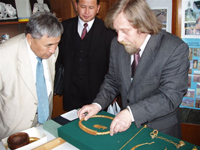|
A large scale exhibition devoted to the finds from the Scythian burial  mounds in Altai, Tuva, Khakassia, Kazakhstan, Ukraine, Romania, North Iran will open in Germany in January, 2007, as Alexandr Brokert, vice-prime-minister of Tuva reported to Tuva-Online. It will be placed in the Martin-Gropius-Bau Museum of the former arts and crafts in Berlin and then throughout the year will move to Frankfurt, Munchen, Hamburg. The central part of the multifacetous 'Scythian World' exhibition will be occupied by the Tuvan finds, mostly from the Arzhaan-2 burial mound. mounds in Altai, Tuva, Khakassia, Kazakhstan, Ukraine, Romania, North Iran will open in Germany in January, 2007, as Alexandr Brokert, vice-prime-minister of Tuva reported to Tuva-Online. It will be placed in the Martin-Gropius-Bau Museum of the former arts and crafts in Berlin and then throughout the year will move to Frankfurt, Munchen, Hamburg. The central part of the multifacetous 'Scythian World' exhibition will be occupied by the Tuvan finds, mostly from the Arzhaan-2 burial mound. The discovery of an untouched Scythian tomb containing a five kilogramme hoard of the earliest ever recovered Scythian gold preceding Greek influence, made by a Russian-German archaeological team in August, 2001, was hailed by scholars as one of the most significant finds in the study of the fierce nomadic Scythian tribes who roamed the steppe stretching from the Carpathian Mountains in Eastern Europe to the northern borders of China in the seventh to third centuries before Christ.  The two-month dig, begun in May, led to the discovery of about 5,000 decorative objects, mostly small pieces of jewellery, such as earrings, pendants and beads, adorning the bodies of a Scythian man and woman, presumably royalty. The two-month dig, begun in May, led to the discovery of about 5,000 decorative objects, mostly small pieces of jewellery, such as earrings, pendants and beads, adorning the bodies of a Scythian man and woman, presumably royalty.
“It is a very rich find and there are many great works of art, figures of animals, necklaces, and pins with animals carved into a golden surface,” said Hermitage Museum director, Mikhail Piotrovsky. “It is an encyclopedia of Scythian animal art because you have all the animals which roamed the region such as panther, lions, camels, and deer. These works show a new Scythian style, something that resembles almost an art nouveau style.” That expedition was headed by Konstantin Chugonov, who has been studying Bronze Age and Scythian sites in Tuva for the past 20 years. German scholars were led by Herman Parzinger and Anatoli Nagler from the German Archeological Institute in Berlin. The idea of the 'Scythian World' exhibition was inspired by the discovery of 2001 in Tuva, said Herman Parzinger to Tuvan journalists during his visit earlier summer this year. It was later on negotiated with the Tuvan Government and this summer after Tuva prolonged its agreement with the State Hermitage on a temporary storage of the 'Arzhaan' finds in Hermitage the plan became more feasible. The State Hermitage is now acting in this large-scale project as a co-partner of Deutsche Archäologische Institut . Within the framework of the 'Scythian World' exhibition Tuva will have a brilliant chance to be presented to foreign public at large, said Alexandr Brokert.
|
|
